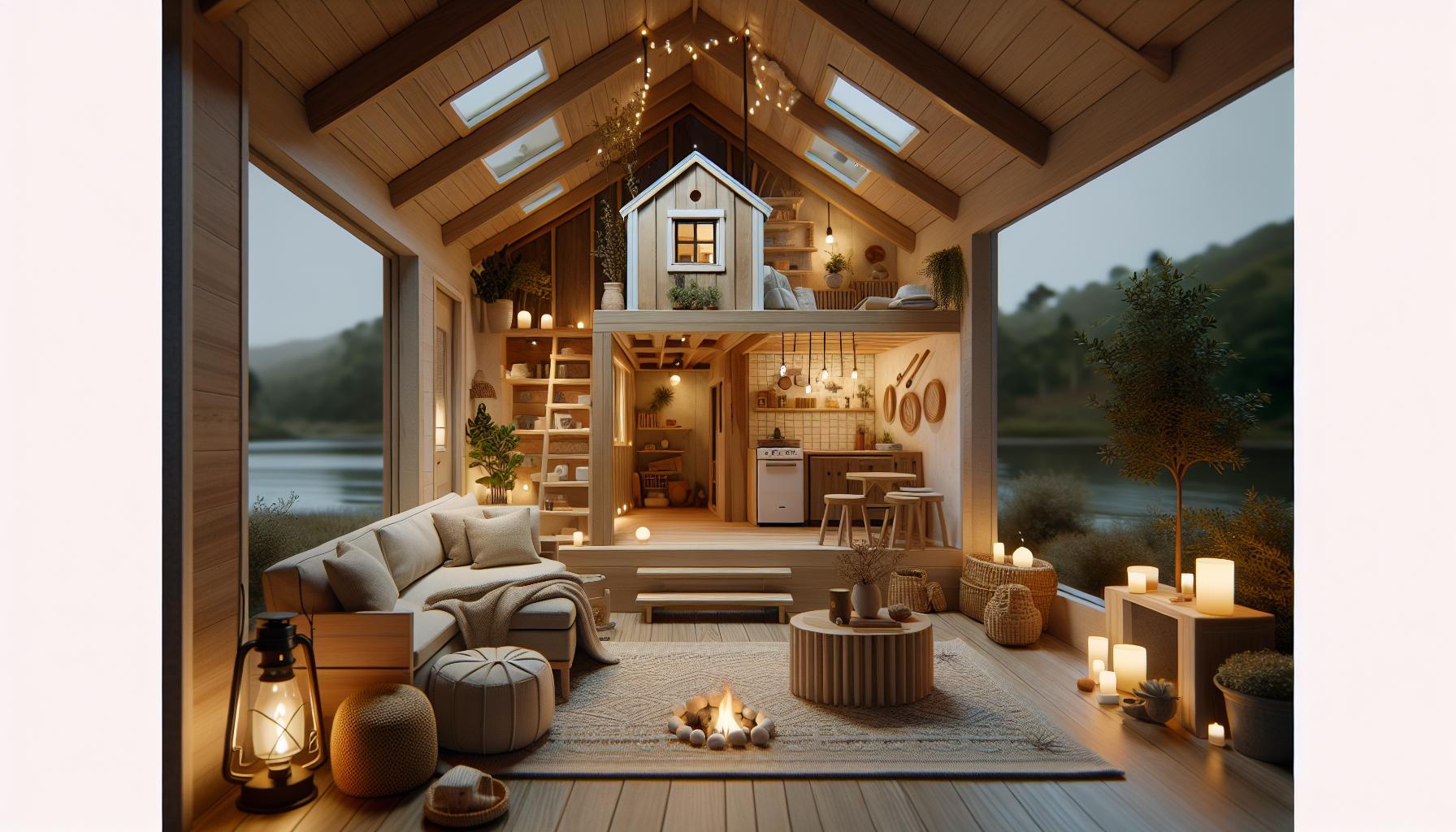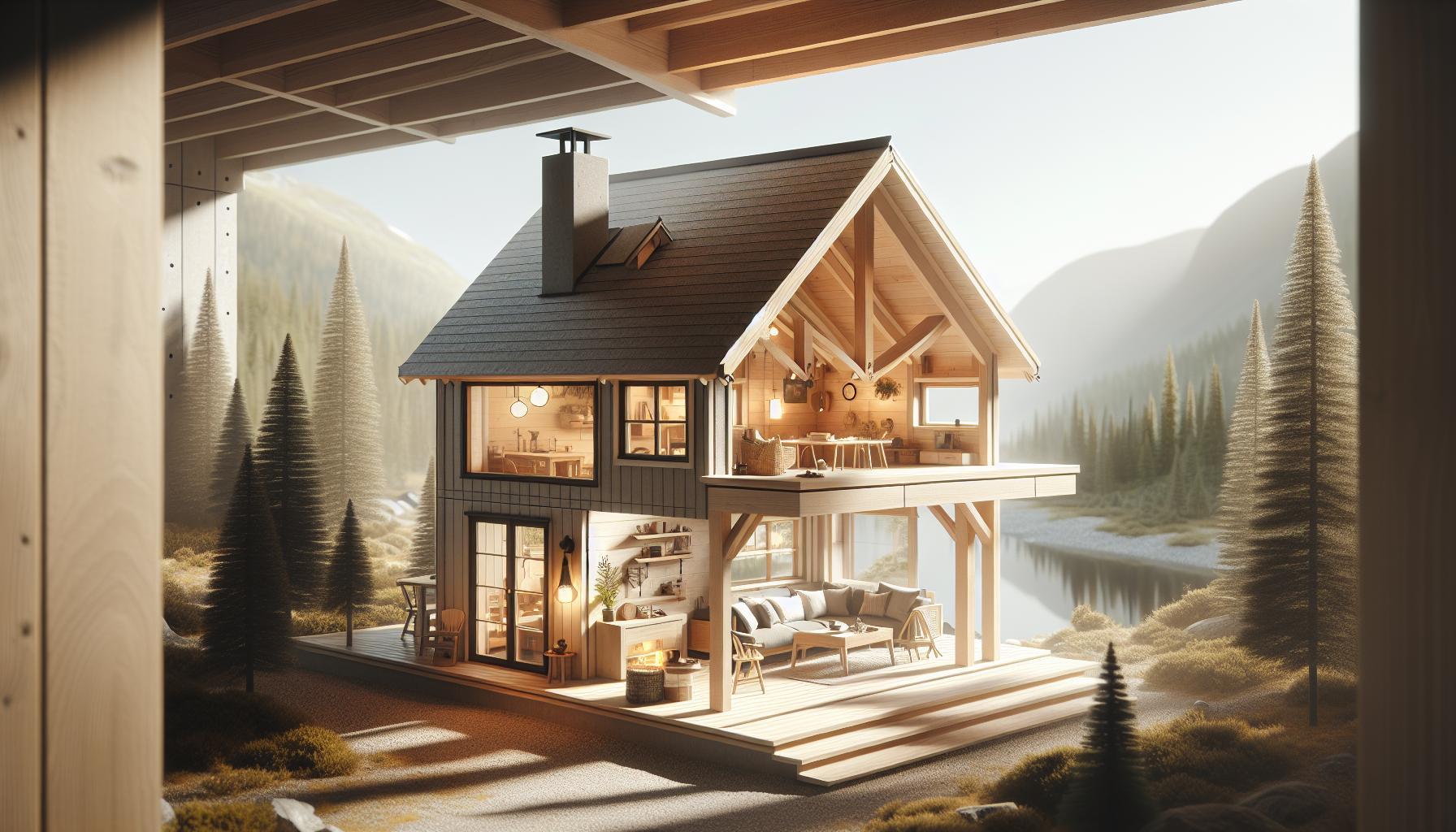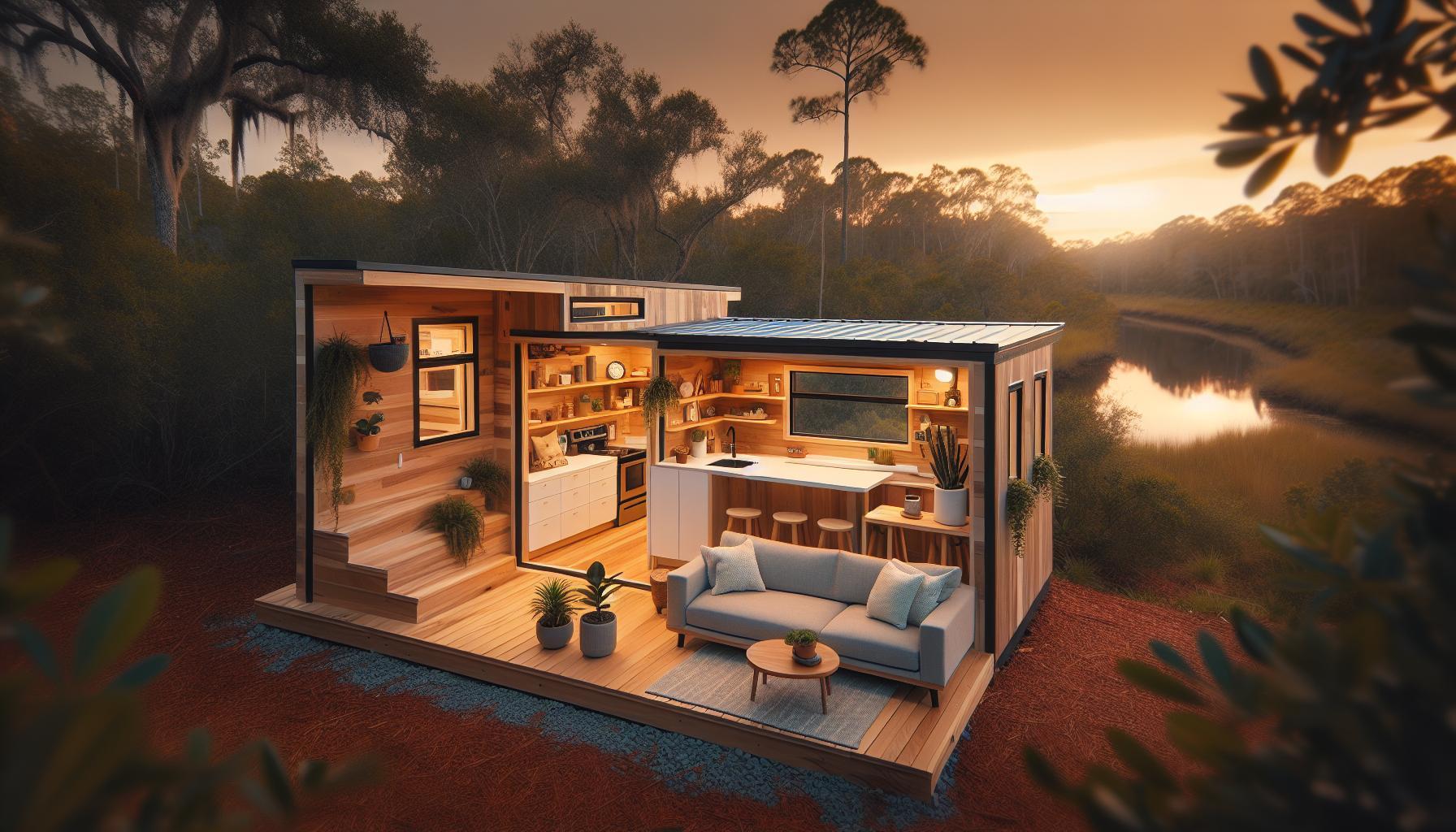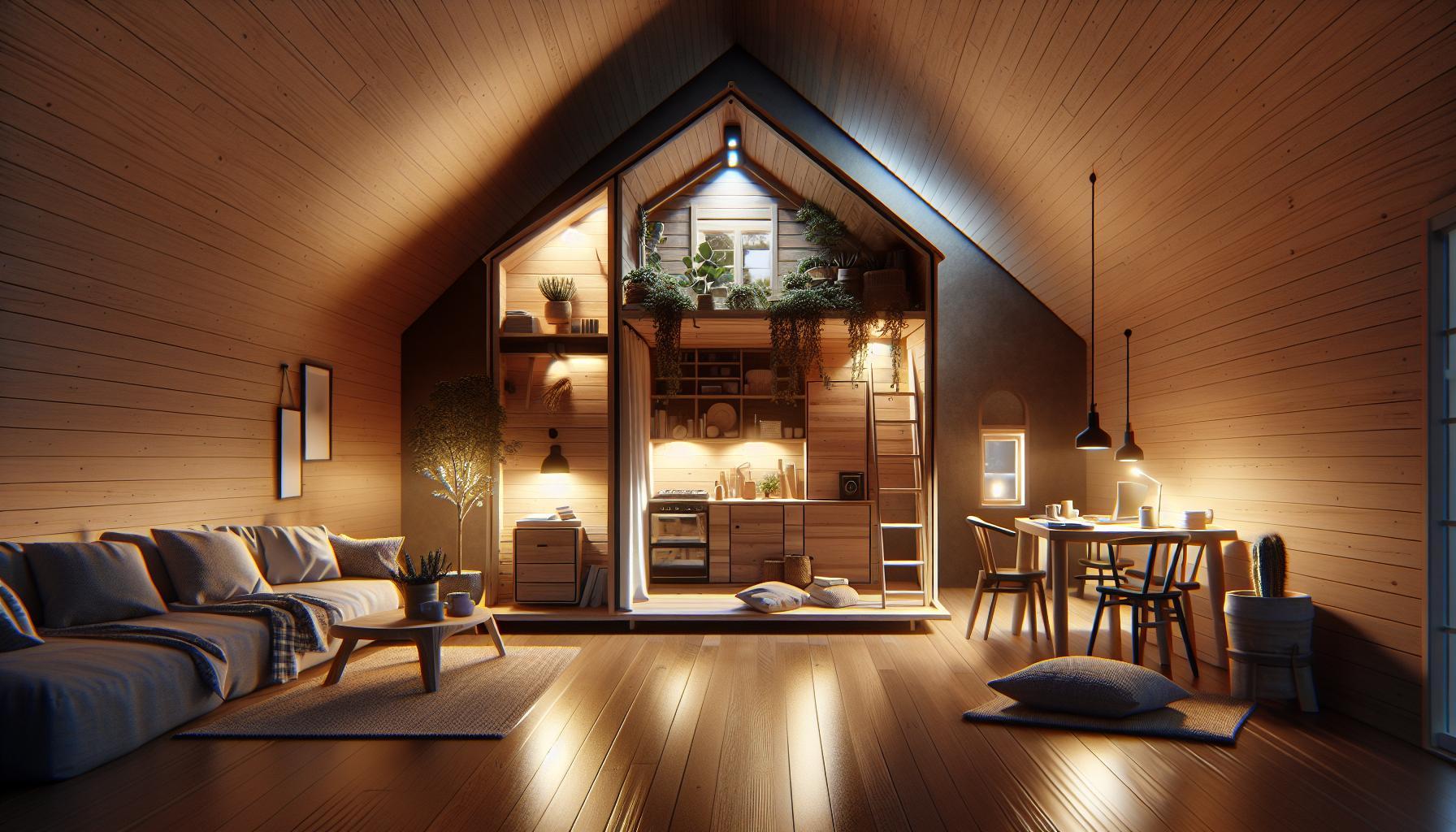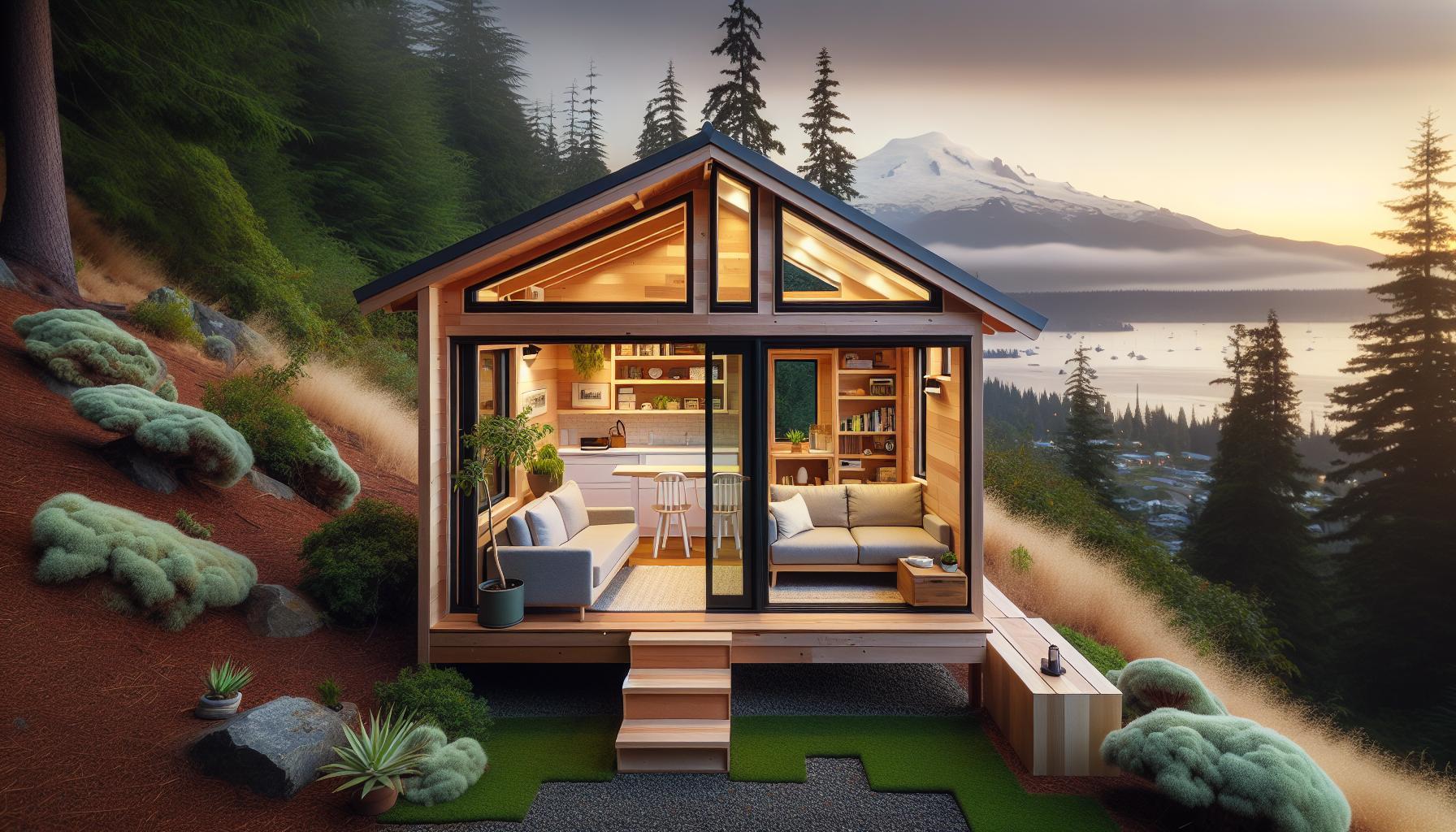As the tiny house movement gains popularity, manny dream of downsizing to a modest abode in the Palmetto State. However,potential builders must navigate South Carolina’s unique zoning laws and regulations regarding tiny homes.Understanding these requirements is essential to making your tiny home vision a reality in this charming southern habitat.
Understanding the Legal Landscape: Zoning Laws and Building Codes in South Carolina
Navigating the intricacies of building regulations can frequently enough feel overwhelming, especially for innovative housing solutions like tiny houses. In South Carolina, zoning laws and building codes play a critical role in determining whether you can successfully construct a tiny house. Understanding these legal frameworks is crucial for anyone looking to venture into this compact living space venture, as they dictate everything from where you can build to the standards your tiny home must meet.
Zoning laws are municipal regulations that outline how land in specific areas can be used. In south Carolina, local governments enforce these laws, and they vary significantly from one municipality to another. Generally, zoning classifications such as residential, commercial, and agricultural dictate whether tiny houses can be built in a certain area. For example, many areas zoned for residential use may allow tiny homes, but only as accessory dwelling units (ADUs) on properties with existing larger homes. It is indeed essential to check with the local zoning board or planning department to understand the specific regulations applicable in your area, such as minimum lot sizes and density restrictions.
Building codes, on the other hand, ensure that structures meet safety and durability standards. In South Carolina,these codes are primarily influenced by the South Carolina Uniform Building Code,which incorporates international standards. Tiny houses, while smaller, must adhere to the same building codes as larger homes, ensuring that they are safe for habitation. This includes regulations on plumbing, electrical systems, and structural integrity. Some localities may even have specific codes pertaining to tiny homes, so conducting thorough research and possibly consulting with a professional can provide clarity on compliance requirements.
To assist potential builders in understanding the landscape, here’s a simplified overview of the steps to consider when planning a tiny house in South Carolina:
| Step | Description |
|---|---|
| 1. Research Local Zoning Laws | Check with your municipal zoning office to determine if tiny homes are permitted in your desired area. |
| 2. Confirm Building Codes | Ensure compliance with state and local building codes, including safety requirements for utilities and structure. |
| 3. Obtain Necessary Permits | Apply for building permits and any additional permissions, such as those for utility connections. |
| 4. Plan for Utilities | Explore options for water, sewage, and electricity to ensure your tiny house can be fully functional. |
With careful preparation and a thorough understanding of local regulations, building a tiny house in South Carolina can indeed be feasible. By engaging with local authorities and staying informed about the zoning laws and building codes,you can significantly increase your chances of successfully establishing a tiny home in the Palmetto State.
Choosing the Right Location: Where to Place Your Tiny House in the Palmetto State
finding the ideal spot for your tiny house in South Carolina is vital to ensure compliance with local regulations and to enjoy the lifestyle benefits of this compact home. The Palmetto State offers diverse geographical locations ranging from coastal areas to mountainous terrains, each presenting unique advantages and challenges. Understanding local zoning laws and community guidelines is crucial in your search for the perfect setting.
Key Considerations for location
When deciding where to place your tiny house, consider the following factors:
- Zoning Regulations: Different counties in South carolina have varying regulations regarding tiny homes. Areas like horry and Greenville allow for tiny houses, while others may impose restrictions. It’s essential to verify each county’s zoning laws before making any decisions[[3]](https://www.greatlakestinyhome.com/what-counties-in-south-carolina-allow-tiny-houses/).
- Community Resources: Numerous tiny home communities in South Carolina provide not just space but also facilities and a like-minded community. Areas such as those highlighted by Titan Tiny Homes are ideal for new owners looking for camaraderie and support[[1]](https://www.titantinyhomes.com/tiny-home-communities/south-carolina/).
- Access to amenities: Consider the proximity of your tiny house to local amenities such as grocery stores, healthcare facilities, and recreational areas. A location that balances tranquility with convenience supports a enduring and enjoyable living environment.
exploring Tiny Home communities
One of the most appealing aspects of choosing to live in a tiny house in South Carolina is the availability of dedicated tiny home communities. These neighborhoods cater specifically to the needs of tiny home dwellers, providing a sense of belonging and community. From shared amenities like gardens and workshops to organized social events, living in one of these communities can enhance your tiny house experience significantly[[2]](https://www.tinyhouse.com/post/tiny-house-communities-in-south-carolina).
To make the most informed decision, you should visit potential locations, talk to residents if possible, and assess the lifestyle each community can offer. Consider creating a shortlist of preferred locations and reach out to local zoning officials to clarify any questions about building regulations and permits.
selecting the right location for your tiny house in South Carolina involves thorough research into zoning regulations, exploring existing tiny home communities, and considering the amenities that will enhance your lifestyle. By making informed choices, you can create a fulfilling tiny living experience that aligns with your values and aspirations.
navigating Tiny House Regulations: Permits and Inspections you Need to Know
Building a tiny house in South Carolina can be an exciting venture,but it’s essential to be aware of the local regulations governing this burgeoning trend. Each municipality within the Palmetto State may have different requirements,making it crucial to navigate through the maze of permits and inspections effectively.
Understanding the Permit Process
Before you start construction on your tiny home, you’ll need to obtain the appropriate permits. Here are the primary types you may encounter:
- Building Permits: These are typically required for any structure, including tiny houses. The permit ensures that your construction meets local building codes and safety standards.
- Land Use Permits: Depending on your land type, special zoning permits may be necessary. For instance, if you’re placing your tiny house on land not specifically zoned for residential use, you might need to apply for a variance.
- Electrical and Plumbing Permits: If your tiny house includes these systems, ensure that you obtain separate permits. This step is crucial for inspections and guarantees compliance with safety standards.
Once you’ve identified the required permits, check with your local zoning office or planning department. Many local governments in South Carolina have streamlined their permitting processes, so you might potentially be able to complete some steps online.
Inspections: What to Expect
Inspections are a crucial part of the building process. They ensure that the construction adheres to local building codes and is safe for habitation. Here’s what to anticipate:
- Foundation Inspection: Before pouring your foundation, an inspector will assess the site to ensure it meets local requirements.
- Framing Inspection: Once the framing is completed but before insulation is added, a framing inspection will verify that the structure’s skeleton is sound.
- Final Inspection: After completing all work, a final inspection will determine if your tiny house is ready for occupancy.
Having a checklist can simplify this process, allowing you to track your progress and stay organized.
| Inspection Type | Description | Timing |
|---|---|---|
| Foundation | Verify site suitability for foundation work. | Prior to foundation work |
| Framing | Check structural integrity and framing methods. | After framing but before insulation |
| Final | Ensure all work complies with safety codes. | Post-construction |
Engaging with your local planning and zoning boards early in the process will aid in gathering necessary information and preventing delays.By understanding and following the regulations on building a tiny house in South Carolina, you can create a lovely, functional living space that complies with all safety standards.
Designing Your Dream: Key Considerations for Tiny House Layouts in South carolina
Designing a tiny house is a thrilling endeavor, especially in a state as picturesque and varied as south Carolina. The vibrant landscapes,from the coastal charm of the Lowcountry to the rolling hills of the Upstate,offer unique inspirations for your tiny home layout. Given the burgeoning trend of minimalist living and the increasing interest in local zoning regulations detailed in the article on tiny house rules, it’s essential to understand how to maximize your space while complying with state laws.
Maximizing Space and Functionality
A key aspect of creating an efficient tiny house layout is the thoughtful arrangement of space to enhance both functionality and comfort. Here are some considerations to keep in mind:
- Open Floor Plan: Aim for an open layout that combines living,dining,and kitchen areas. This design not only makes the space feel larger but also promotes a sense of flow and connectivity.
- Multi-Purpose furniture: Invest in convertible furniture—like a sofa bed or a foldable dining table. Such pieces ensure that your tiny house remains versatile and adapts to various needs throughout the day.
- vertical Storage: Utilize wall space for storage solutions,such as shelves and cabinets,to keep the floor area clear and maintain an airy environment.
- Natural Light: Incorporate large windows or skylights to invite ample natural light, creating an illusion of space while reducing reliance on artificial lighting.
Incorporating Local Style
When considering the design, take a cue from South Carolina’s rich architectural heritage. You might want to embrace elements that reflect the region’s aesthetic.As a notable example:
- Lowcountry Style: Consider a wooden porch for that quintessential Southern touch, ideal for sipping sweet tea while enjoying the balmy evenings.
- Color Palettes: Use soft, muted tones inspired by the natural environment, such as sea greens and sandy beiges, to evoke a calming retreat.
- Energy Efficiency: Given the warm climate, investing in good insulation and energy-efficient windows is pivotal to keep your tiny house cool during the hot summers.
Adhering to Local Regulations
Understanding the local zoning laws is crucial when asking yourself, “Can you build a tiny house in South Carolina?” Each municipality may have different requirements regarding square footage, height restrictions, and required amenities. Familiarize yourself with the following:
| Aspect | Considerations |
|---|---|
| Minimum Size | Some areas require a minimum size of 400 sq. ft. for a dwelling. |
| Land Use | Ensure the land is zoned for residential use if you’re looking to build on private property. |
| Utility Hookups | Check local guidelines for requirements on plumbing and electrical connections. |
| Permits | Obtain necessary building permits before starting construction to avoid fines or setbacks. |
By taking these factors into account, you’re not just building a tiny house; you’re crafting a personal sanctuary that harmonizes with the beautiful South Carolina landscape, fits within legal confines, and embodies a lifestyle that can inspire others in your community.
Sustainable Living: Eco-Friendly Practices for your Tiny house Build
When considering a tiny house build in South Carolina,eco-friendly practices can significantly enhance both your living experience and the environment. embracing sustainable living not only reduces your ecological footprint but can also lead to long-term savings. Utilizing renewable resources and making mindful choices during construction can turn your tiny home into a model of modern sustainability.
Choosing Sustainable Materials
Selecting eco-friendly materials is paramount when constructing a tiny house. Consider using reclaimed wood for both structural elements and interior finishes, which reduces waste and gives your home a unique character. Additionally, opting for low-VOC (Volatile Organic Compound) paints and finishes helps maintain indoor air quality, making your space healthier for you and the environment.For insulation, materials like sheep’s wool, cellulose, or recycled denim offer effective thermal resistance while being more sustainable than conventional fiberglass.
Implementing Energy-Efficient Designs
Incorporating energy-efficient designs will enhance both the sustainability and comfort of your tiny home. Here are a few key strategies to consider:
- Orientation: Position your tiny house to maximize natural light and solar gain. South-facing windows can significantly reduce heating costs in winter.
- Insulation: Proper insulation is vital. Choose high-performance insulation materials that can keep your home warm in the winter and cool in the summer.
- Appliances: Invest in energy Star-rated appliances that consume less energy and help minimize your overall electricity use.
- Renewable Energy: Integrating solar panels can reduce reliance on grid electricity,furthering your commitment to sustainable living.
Water Conservation Practices
Water conservation is crucial, especially in regions where water resources can be limited. Installing rainwater harvesting systems can provide a sustainable water source for non-potable uses such as irrigation and toilet flushing. Additionally, consider implementing low-flow fixtures and composting toilets, which reduce water consumption while promoting a more sustainable lifestyle within your tiny house.
By implementing these eco-friendly practices,you can ensure that your tiny house not only aligns with the principles of sustainability but also contributes positively to the environment. This thoughtful approach to your build demonstrates how the tiny home movement can lead to a more responsible and sustainable way of living, particularly in states like South Carolina, where regulations can often complement eco-conscious building practices.
Financing Your Tiny Adventure: Options for Budgeting in South Carolina
The allure of tiny house living is undeniable, especially in a picturesque setting like South Carolina. With its rich history, natural beauty, and welcoming climate, the Palmetto State offers an ideal backdrop for minimalist living. However, before diving headfirst into this adventurous lifestyle, aspiring tiny home builders need to consider their financing options carefully. Understanding the financial landscape can transform your tiny house dream into a reality without straining your budget.
Understanding Tiny Home Financing Options
Navigating the financial aspects of building a tiny house can seem daunting,but there are several options available tailored to different needs and situations. Here are some common avenues to explore:
- Personal loans: ideal for those with good credit, personal loans offer a straightforward way to fund your tiny house construction. These unsecured loans allow you to borrow a specific amount without collateral, making them easier to obtain.
- RV Loans: if your tiny house is built on a trailer, you might be able to secure financing through RV loans, which generally have favorable interest rates and flexible terms.
- Construction Loans: For more conventional builds, a construction loan can help you fund the project from start to finish. These often convert to a mortgage upon completion, allowing you to spread out payments over time.
- Home Equity Loans: If you already own property,tapping into your home equity can provide the necessary funds. This option typically comes with lower interest rates than other loans, due to the equity backing.
Grants and Assistance Programs
In the spirit of community support, South Carolina has various grants and assistance programs aimed at helping residents achieve affordable housing solutions. Research local nonprofit organizations and government programs that align with sustainable living initiatives. For instance, some state programs may offer financial assistance or incentives for energy-efficient builds, making building your tiny home more financially feasible.
Cost-Saving Strategies for your Tiny Build
In addition to understanding financing options, implementing cost-saving strategies can help stretch your budget further. Consider these practical tips:
- DIY projects: Embarking on do-it-yourself projects for parts of your build can significantly reduce labor costs. Whether it’s framing, painting, or interior design, hands-on involvement can be rewarding and budget-friendly.
- Repurposing Materials: Look for reclaimed or used materials to save on costs. Salvage yards, online marketplaces, and community exchanges are excellent sources for quality supplies that can lend character to your tiny home.
- Keep It Simple: Consider minimizing your design complexity. Focusing on a more straightforward layout can reduce both materials and labor costs, making your tiny house financing more manageable.
By exploring these diverse financing options and smart budgeting strategies, you will be well on your way to realizing the dream of building a tiny house in South Carolina, all while navigating the essential Palmetto State rules.
Community and Connection: Finding Tiny House Networks and Resources locally
South carolina’s burgeoning tiny house community offers an exciting opportunity for those looking to simplify their lives and embrace smaller living spaces. However,navigating the local landscape of resources and connections is essential for potential tiny home builders. Engaging with local networks and utilizing available resources can greatly enhance your experience, provide valuable insights, and even fuel your motivation as you embark on this eco-friendly journey.
Connecting with Local Tiny House Enthusiasts
The path to discovering the joys and challenges of tiny house living begins with connecting to local communities. Here are some avenues to explore:
- Social Media Groups: Platforms like Facebook host numerous groups dedicated to tiny living, such as “Tiny Houses South Carolina” or “Tiny Living in the South.” these groups frequently enough share valuable experiences, answer questions about building practices, and organize meetups.
- Meetup.com: this website is an excellent resource for finding local events and gatherings focused on tiny houses. Look for informal gatherings, workshops, or even tours of tiny homes in your area.
- Local Workshops and Expos: Attend workshops or home expos that focus on sustainable living or DIY construction. These events are perfect for networking with like-minded individuals and experts.
Online Resources and Directories
The digital age makes it easier than ever to find tiny house networks and resources tailored to South Carolina residents.Consider utilizing the following tools:
| Resource | Description | Website |
|---|---|---|
| Tiny House Community | A comprehensive directory of tiny home builders, communities, and resources. | tinyhousecommunity.com |
| American Tiny House Association | advocacy group providing resources and connections for tiny house advocates. | tinyhouseinstitute.com |
| the tiny Life | A popular blog featuring guides, stories, and advice about tiny living. | thetinylife.com |
Local Building Resources
While creating a tiny home, understanding zoning laws, building codes, and available materials is vital. Engaging a local builder who specializes in tiny homes can be a solid investment. Additionally, explore local hardware stores and lumber yards that may offer discounts for sustainable materials. Getting to know your local officials—like zoning officers or building inspectors—can also provide clarity on what’s allowable for tiny homes in your area.
in essence, building your small sanctuary in South Carolina involves more than just construction; it requires community engagement and resourcefulness. By tapping into these networks and leveraging online resources, you can connect with fellow tiny house proponents, gain insights on overcoming potential challenges, and most importantly, enjoy the journey of tiny living!
Embracing Minimalism: The Lifestyle Benefits of Living in a Tiny House
Imagine waking up in a space that embodies simplicity and tranquility, where every item serves a purpose and every inch is thoughtfully designed. Living in a tiny house not only embraces minimalism but also cultivates a lifestyle that inspires intentional living, particularly appealing in regions such as South Carolina, where the desire for unique housing options is growing. As the tiny house movement gains momentum, prospective homeowners are increasingly drawn to the benefits tied to downsizing, especially under the framework of Can You Build a Tiny House in South Carolina: Palmetto State Rules.
Financial Freedom
One of the most compelling advantages of tiny house living is financial freedom. The reduced size leads to significantly lower costs, from initial construction expenses to ongoing utility bills. With the ability to construct a tiny house within the guidelines set forth in the Palmetto State, individuals can avoid hefty mortgages and instead focus on saving or investing those funds in more fulfilling experiences. here are a few financial benefits to consider:
- Lower Mortgage or rent: Many tiny houses can be financed with smaller loans or even no loans at all, leading to actual ownership without long-term debt.
- Reduced Utility Costs: A smaller space requires less energy to heat and cool, resulting in monthly savings on bills.
- Less Maintainance: Fewer square feet mean less upkeep, reducing the time and money spent on maintenance and repairs.
Environmental Impact
The environmental footprint of a tiny house compares favorably to traditional homes. By minimizing living space, homeowners naturally consume fewer resources. This commitment to sustainability resonates well in South Carolina, where residents are increasingly aware of ecological concerns.Compact living promotes eco-friendly practices, leading to reduced waste and lower energy consumption. When adhering to the building rules in South Carolina, embracing eco-conscious materials and systems in tiny house construction can amplify these benefits, such as solar panels and greywater recycling systems.
Enhanced lifestyle Quality
Living in a tiny house forces individuals to reflect on what truly matters to them, promoting a simplified lifestyle focused on experiences rather than possessions. Throughout South Carolina, tiny homeowners report enhanced mental clarity and emotional well-being as decluttering leads to reduced stress. by concisely curating their belongings, they find greater satisfaction in quality over quantity. Here’s how tiny living can improve lifestyle quality:
- Increased Mobility: The option to relocate can provide a sense of adventure and change, whether moving to different areas or simply changing the view.
- Stronger community Bonds: many tiny house owners become part of a close-knit community,often participating in cooperative living arrangements or tiny house festivals.
- Time for What Matters: With fewer chores and obligations tied to maintenance and upkeep, tiny house dwellers often find more time to spend with loved ones or engage in hobbies.
Ultimately, the decision to build a tiny house in South Carolina not only complies with regulations set forth in Can You Build a Tiny House in South Carolina: palmetto State Rules but also opens the door to a lifestyle rooted in minimalism, sustainability, and personal fulfillment. As more individuals seek to eliminate the clutter of modern life, aspiring tiny homeowners can transform their lives as they embrace the benefits of loving less and living more.
Q&A
Can You Build a Tiny House in South Carolina: Palmetto State Rules?
Yes, you can build a tiny house in South carolina, but there are specific regulations you’ll need to follow. Local zoning laws, building codes, and permits play crucial roles in your project’s success. Always verify with your local authorities before starting your build.
What are the zoning regulations for tiny houses in South Carolina?
Zoning regulations in South Carolina vary by municipality. Many areas allow tiny houses as accessory dwelling units, while others may restrict them to specific zones.It’s essential to check with your local planning department to ensure compliance.
Do I need a permit to build a tiny house in South Carolina?
Yes, most cases will require a building permit to construct a tiny house in South Carolina. Obtaining a permit ensures that your structure meets safety codes and local ordinances.Lack of proper permits may lead to fines or necessitate removal of the building.
Can I live in a tiny house full-time in South Carolina?
Some areas may allow tiny houses on residential lots, yet others could restrict full-time occupancy to designated RV parks or similar uses.
What building codes apply to tiny houses in South Carolina?
Building codes for tiny houses in South Carolina typically follow the International Residential Code (IRC). These codes ensure structures are safe and livable. Compliance with electrical, plumbing, and structural safety requirements is crucial.
how do I find land to build a tiny house in South Carolina?
Finding land for a tiny house can be approached through real estate listings or local classifieds. Engage with local real estate agents familiar with tiny home zoning. Places like Tiny Home Builders offer resources that may connect you with suitable land.
Can I place a tiny house on a mobile home lot in South Carolina?
Placing a tiny house on a mobile home lot is frequently enough allowed, provided it meets local zoning and regulations. check with the property owner and local regulations to ensure your tiny house complies with the area’s requirements.
The Way Forward
building a tiny house in South Carolina can be an exciting journey towards minimalism and a unique lifestyle choice. While certain counties like Horry and Greenville have embraced the tiny house trend by permitting their construction, it is crucial to navigate the varied regulations that apply to each locality. Zoning laws, building codes, and land use regulations can differ significantly, impacting everything from the design of your tiny home to where you can place it.For those eager to dive into this lifestyle,the supportive communities dedicated to tiny living offer a wealth of resources and camaraderie. Engaging with local builders and networks can provide valuable insights into overcoming challenges and realizing your dreams of tiny house living. Whether you’re a novice or a seasoned builder, understanding these legal landscapes will help ensure that your tiny house is not only a reflection of your personal values but also a compliant structure within the Palmetto State.
So, as you embark on this exhilarating venture, remain informed and flexible.The tiny house movement embodies a beliefs of simplicity and sustainability, inviting you to embrace both the ideals and practicalities of this lifestyle.Explore further, connect with local communities, and uncover the countless resources available to guide you on your path to building your very own tiny haven in South Carolina.

